Case Study: Accusations of Fraud and Falsification of Evidence in the Interpretation of New World Myths An article written by Duncan Edlin hosted on the In the Hall of Ma’at website entitled The Gentle Art of Myth Management.
Response by Graham Hancock to The Gentle Art of Myth Management by Duncan Edlin. Graham’s comments were originally posted on the GHMB on 11 November 2001. All page numbers from Fingerprints of the Gods refer to the UK paperback edition of 1996 (and subsequent reprints of the same edition). Different page numbers may apply in other editions.
The first point in Duncan’s critique on which I wish to comment is the very serious allegation that I “introduced” the word “white” into a myth that I quoted from Harold Osborne’s South American Mythology, page 87. This looks bad for me as Duncan presents it to the readers of Ma’at. What he fails to note, however — a selective misrepresentation on his part that works greatly to my detriment — is that I took the word “white” that I use here from an earlier description of Viracocha also given by Osborne on page 74 of the same book. So what I am “guilty” of is, at the very most, sloppy editing, certainly not misrepresentation as Duncan implies. Had I put in dots to indicate lacunae and referred the reader to page 74 of Osborne as well as to page 87, then there would be nothing to accuse me of here at all.
Let’s go through this in detail.
(1) Osborne’s text on page 74 (citing Cieza de Leon) states that Thunupa/Viracocha was:
…a white man of large stature and authoritative demeanour…
(2) Osborne’s text on page 87 (citing Antonio de la Calancha?) states that Thunupa/Viracocha
…appeared on the Altiplano in ancient times, coming from the north with five disciples. He was a man of august presence, blue-eyed, bearded, without headgear and wearing a cusma, a jerkin or sleeveless shirt reaching to the knees. He was sober, puritanical and preached against drunkenness, polygamy and war.
My abridgement of these two passages in Fingerprints (Chapter 9, page 70 of UK paperback edition) reads in full as follows:
Thunupa appeared on the Altiplano in ancient times, coming from the north with five disciples. A white man of august presence, blue-eyed and bearded, he was sober, puritanical and preached against drunkenness, polygamy and war.
I made use of essentially the same abridgement/quotation, with slight differences, in Chapter 6 of Fingerprints, (page 51 of UK paperback edition) alongside citations from other myths. There I wrote:
In one legend Thunupa-Viracocha was said to have been a “white man of large stature, whose air and person aroused great respect and veneration.”
[Source given, John Hemming, The Conquest of the Incas, Macmillan 1993, page 97; the quotation is correct]
In another he was described as a white man of august appearance, blue-eyed, bearded, without headgear and wearing a cusma, a jerkin or sleeveless shirt reaching to the knees.”
[No source given although clearly derived from the same passages on pages 74 and 87 of Osborne cited above; quotation marks closed but not opened]
In yet another, which seemed to refer to a later phase of his life, he was revered as “a wise counsellor in matters of state’ and depicted as ‘an old man with a beard and long hair wearing a tunic.”
[Source given, Osborne, South American Mythology, page 87; my phrase is an abridgement of Osborne’s original which read, “a poor thin old man with a beard and long hair had come to them in a long tunic… he was a wise counsellor in matters of state… his name was Thunupa Vihinquina.”]
Interestingly, Duncan Edlin’s article draws attention to my use of the same myth in Heaven’s Mirror where I write that Viracocha was emphatically described as “a white man… blue-eyed and bearded… of large stature and authoritative demeanour… In many places he gave men instructions how they should live.” (page 275)
The source that I give for this is Osborne, page 74 and Duncan correctly points out that “there is absolutely no mention of anybody being ‘blue-eyed and bearded’ on this page” [i.e. page 74 of Osborne] – thus again suggesting that I have deliberately mislead my readers. However Duncan fails to mention a crucial fact (an omission on his part that once again works to my detriment). The reference I cite here to Viracocha being “blue eyed and bearded” does appear in Osborne, but on page 87.
All I have done is run together two references to Thunupa/Viracocha, both from Osborne.
In Fingerprints I was sloppy. I didn’t put in dots to indicate lacunae. I abridged rather than quoted the passages word for word, and I cited only page 87 of Osborne when I should have cited page 74 as well. In Heaven’s Mirror I was much less sloppy. I did put in dots to indicate lacunae. These dots correctly separate “a white man” [page 74 of Osborne and describing Thunupa/Viracocha] and “blue eyed and bearded” [page 87 of Osborne and describing Thunupa/Viracocha]. My sloppiness in Heaven’s Mirror was only to cite page 74 of Osborne this time and to forget to cite page 87!
But as Duncan’s own use of quotations from me shows, he is thoroughly familiar with both pages 74 and page 87 of Osborne – the very pages that contain the descriptions of Thunupa/Viracocha as “a white man” and as “blue-eyed, bearded.”
I am sure that anyone who does not automatically assume that I am some sort of crook, fraud or charlatan will see why I had no problem in conflating these two fragments of myth – both from Osborne, both about Thunupa/Viracocha and both describing a personage of Caucasian type (whether simply as “a white man” in one or as “blue-eyed” in the other).
It was sloppy of me not to put in dots to indicate lacunae and it was sloppy of me not to cite both page refs.
But sloppiness is not fraud and does not warrant Edlin’s defamatory and professionally-damaging allegation that I have severely breached my relationship of trust with my readers. This is all the more true because, despite my sloppiness, I did represent Osborne correctly. He does describe Thunupa/Viracocha as “a white man” (page 74) and he does describe Thunupa/Viracocha as “blue-eyed, bearded” (page 87). The proof of how I derived this representation from Osborne, and that it is not fraud, is absolutely contained in the correct placing of dots to mark lacunae in the very passage from Heaven’s Mirror that Duncan quotes.
Moving on I note that Duncan Edlin’s article also presents another case of alleged fraud on my part that bears closer examination.
Edlin writes,
In Chapter 5 of Fingerprints of the Gods, Hancock states, “Other accounts of Viracocha likened his appearance to that of Saint Thomas.” Hancock once again refers to Osborne’s book (page 81) as the source of this information. But on this page Osborne doesn’t state that Viracocha resembled St Thomas at all. Instead the text states clearly that he was St Thomas. Osborne is quoting from Juan Santa Cruz Pacahuti Yamqui Salcamayhua: An account of the Antiquities of Peru, which states: “He was called Thunupa Viracochanipachan, but surely he was the glorious apostle St Thomas.”
Once again the thrust of Duncan’s commentary here is to insinuate some kind of fraud on my part – in this case that I have misrepresented the Saint Thomas story to imply that Viracocha LOOKED LIKE Saint Thomas when in fact the original text said that Viracocha WAS Saint Thomas.
Well it beats me how someone could BE Saint Thomas but not LOOK LIKE him. More to the point, however, I don’t understand why Duncan fails to quote the passage that I wrote immediately prior to this in Chapter 5 of Fingerprints:
It seemed that in the early sixteenth century, before the Spanish began to demolish Peruvian culture in earnest, an idol of Viracocha had stood in the holy of Holies of the Coricancha. According to a contemporary text, the Relacion anonyma de los costumbres antiques de los naturals del Piru, this idol took the form of a marble statue of the god – a statue described ‘as to hair, complexion, features, raiment and sandals, just as painters represent the apostle Saint Bartholomew. (Fingerprints page 48, UK paperback edition)
This passage, describing the idol of Viracocha that formerly stood in the Great Temple of Cuzco (later converted into a Christian Cathedral, at which time, presumably, the idol was lost or destroyed) sheds further light on Duncan’s impassioned but unjustified attack on my “methods.” The crux of his argument is that I have misrepresented the myths of Viracocha by failing to acknowledge that they contain a Christian admixture and that it is to this admixture and this admixture alone, rather than any indigenous sources, that we owe the descriptions of Viracocha as a bearded white or pale-skinned foreigner.
I’m therefore not surprised that Duncan, in order to maintain the force of his argument, fails to quote my passage about Viracocha and Saint Bartholomew. This passage refers not to the words of a myth but to the actual appearance of a pre-Columbian statue of Viracocha and it tells us very clearly that it resembled the way that painters represent Saint Bartholomew “as to hair, complexion, features, raiment and sandals.” Since it is unlikely that painters of the era would have represented the Apostle Bartholomew as an Aymara Indian or as an Inca, is this not strong reinforcement for an authentically pre-Columbian tradition of Viracocha as a bearded white man, etc, etc? And doesn’t it directly contradict the notion Duncan wishes to put across that the idea of Viracocha as a bearded white man is nothing more than a post-Conquest Christian invention?
Of course there is much more that contradicts this argument – including in Osborne himself. On page 14, for example, Osborne speaks of “legends of a race of white invaders” with no suggestion that these legends have anything to do with Christian syncretism. On page 42 Osborne states “the official Inca accounts of their legendary origins may fairly be surmised to have taken shape largely by the appropriation of folk stories which long antedated the rise of their dynasty.”
On page 44, again with no suggestion of Spanish or Christian influence, Osborne notes that in one version of the Inca creation myth:
Creation — or at any rate the origin of civilisation – seems to have been linked with the story of a flood. Before the flood men lived in a state of primitive barbarity. After the world had been destroyed by the flood the creator brought into being a new race of men and sent down a culture hero to teach them the arts of civilisation. In the Inca version the sun god takes the place of (or is closely linked with) the creator, and the founders of the Inca race are culture heroes, assuming the characteristics of divine agents who elsewhere bear other names such as Viracocha or Thunupa or Pacamac. The Inca myth is obviously conflated most nearly with the creation story of the southern Altiplano and ties up the origin of the Inca with the sacred lake Titicaca in whose basin stood Tiahuanaco, the capital of an earlier religious culture.
No mention at all of Christian influences here, I note…
Nor are Christian influences mentioned by Osborne in another passage from his South American Mythology that Duncan fails to acquaint us with (pages 71-72):
Before the Incas reigned over them these Indians of the Collao say that there were two great lords in their province, one called Zapana and the other Cari, and that these conquered many pucaras, which are their fortresses. And one of them entered the larger of the two islands in Lake Titicaca and found there a race of white people with beards and fought with them until he killed them all.
So here we have a direct reference in Osborne to a pre-Columbian white bearded race living on the Island of the Sun and clearly with nothing begged, borrowed or stolen from Christian “influences.” Since Duncan Edlin takes such a high moral tone about what he thinks I left out when I cited Osborne I believe it is fair to ask him why he left out this important piece of information given by Osborne? Surely it could not be because it contradicts his own argument? (to say nothing of his own presentation of Osborne’s position?)
Likewise on one of Duncan’s favourite Osborne pages, page 74, we may also read a remark by Cieza de Leon which somehow Duncan fails to quote:
They also relate that long ago in the island of Titicaca there were people with beards like ourselves.
Again nothing to do with Christian influence — but people with beards looking like Cieza de Leon could fairly be described as “bearded white men” rather than as indigenous American Indians.
I don’t understand why Duncan fails to acknowledge this.
So who, exactly, is misrepresenting Osborne?
Besides there are a number of other very cogent reasons why I cannot possibly accept that descriptions in Andean myth of Thunupa/Viracocha as a white bearded foreigner are the result of Christian influence.
First and foremost there is the reception that was accorded to the Spanish conquistadors when they arrived in the Andean region. It is well known, and Duncan Edlin must surely know, that the conquistadors — who were in the main bearded white men — were universally greeted as “Viracochas” on account of their appearance. I state this in Fingerprints, on page 48 of the UK paperback edition but Duncan makes no acknowledgement of this argument.
Here are two reliable sources on the matter:
J. Alden Mason, The Ancient Civilisations of Peru, Penguin 1991 edition, page 135:
Atahuallpa… presumed that the Spaniards were the creator god Viracocha and his demigods returning as had been prophesied by old legends…
The Royal Commentaries of the Inca Garcilaso de La Vega 1539-1616, translated by Maria Jolas, the Orion Press, NY, 1961, page 132
The Peruvian people called the Spaniards “Viracochas” the minute they saw them.
Secondly there is the matter of pre-Hispanic statues, such as the main statue-menhir in the semi-subterranean temple at Tiahuanaco, which depict Viracocha as robed and bearded.
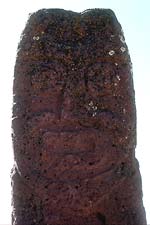 |
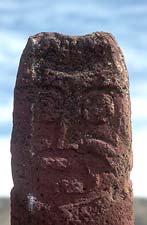 |
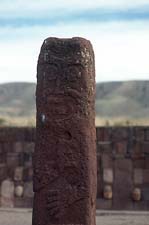 |
 |
| Bearded figure of Viracocha, Tiahuanaco, photographed from different angles | |||
Surely Duncan Edlin does not imagine that the mustachios, goatee beard and large round eyes of this figure (see page 303 of Heaven’s Mirror) are typically “Andean?”
Another figure with extraordinary facial hair is also to be seen at Tiahuanaco.
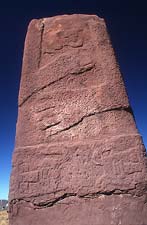 |
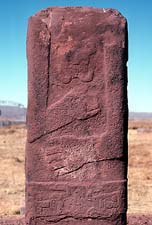 |
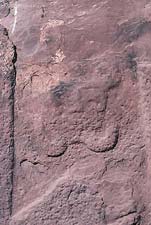 |
| Views of a second representation of a face at Tiahuanaco showing exuberant mustachios or beard (There is a monochrome image in Fingerprints.) | ||
I contend that both these vastly pre-Columbian figures represent physical types that are not indigenous to the South American region.
I keep trying to make the same point about the Quetzalcoatl myth in Central America – that there are surviving pre-Columbian images of great antiquity (such as “The Walker”, La Venta, see page 38 Heaven’s Mirror) which fully justify the notion that the “white bearded foreigner” prototype of Quetzalcoatl is solidly pre-Columbian and cannot be attributed to post-Conquest Christian sources.
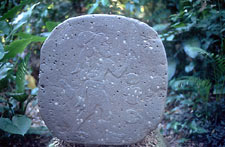 |
| “The Walker”, La Venta. Note facial features and prominent beard. |
To me this sculpture ON ITS OWN does away with the need for further argument on the matter. Nothing said on Ma’at about Christian influence being responsible for the widespread image of Quetzalcoatl as a bearded white man carries anything like the same weight as this silent, sombre piece of carved stone.
But of course it is not alone. Here, to close, are a few more examples – in this case from Monte Alban circa 1000 to 600 BC.
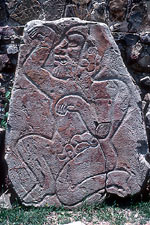  |
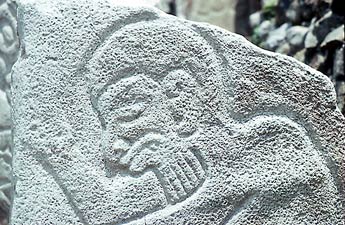 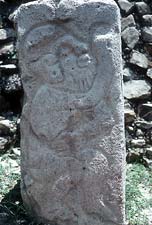 |
| Bearded figures from Monte Alban, Mexico, circa 600 BC |





